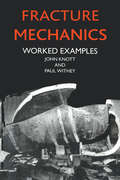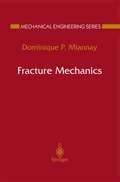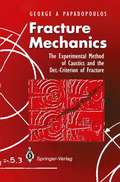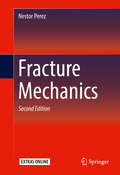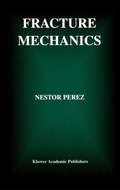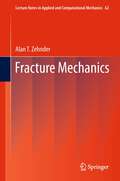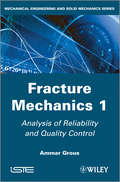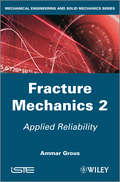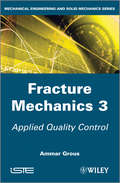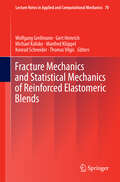- Table View
- List View
Fracture Mechanics: Worked Examples
by John Knott Paul WitneyThis book is aimed at those in both industry and academic institutions who require a grounding not only in the basic principles of this important field but also in the practical aspects of evaluating fracture mechanics parameters.
Fracture Mechanics (Mechanical Engineering Series)
by Dominique P. MiannayIntended for engineers from a variety of disciplines dealing with structural materials, this text describes the current state of knowledge. It begins by describing the fracture process at the two extremes of scale: first in the context of atomic structures, then in terms of a continuous elastic medium. Treating the fracture process in increasingly sophisticated ways, the book then considers plastic corrections and the procedures for measuring the toughness of materials. Practical considerations are then discussed, including crack propagation, geometry dependence, flaw density, mechanisms of failure by cleavage, the ductile-brittle transition, and continuum damage mechanics. The whole is rounded off with discussions of generalised plasticity and the link between the microscopic and macroscopic aspects, and problems are provided at the end of each chapter.
Fracture Mechanics: The Experimental Method of Caustics and the Det.-Criterion of Fracture
by George A. PapadopoulosFracture and Mechanics is concerned with the experimental method of static and dynamic caustics and the Distribution of Determinant (Det.)-criterion of fracture. The Det.-criterion determines the conditions causing a crack and gives information on the expected angle of crack propagation. The object of this publication is to present the latest results to the re.earch and development community and to assist the teaching of experimental fracture mechanics and stress analysis in undergraduate and postgraduate courses. After discussing the basic theoretical considerations on the subject, experimental techniques and applications are introduced. Most of the results presented are based on the author's own investigations in the field of experimental mechanics since 1973 at the National Technical University of Athens.
Fracture Mechanics (Mathematics And Its Applications Ser.)
by Nestor PerezThe second edition of this textbook includes a refined presentation of concepts in each chapter, additional examples; new problems and sections, such as conformal mapping and mechanical behavior of wood; while retaining all the features of the original book. The material included in this book is based upon the development of analytical and numerical procedures pertinent to particular fields of linear elastic fracture mechanics (LEFM) and plastic fracture mechanics (PFM), including mixed-mode-loading interaction. The mathematical approach undertaken herein is coupled with a brief review of several fracture theories available in cited references, along with many color images and figures. Dynamic fracture mechanics is included through the field of fatigue and Charpy impact testing.
Fracture Mechanics (Mathematics And Its Applications Ser.)
by Nestor PerezFracture Mechanics is a graduate level text/professional reference that describes the analytical methods used to derive stress and strain functions related to fracture mechanics. The focus of the book will be on modeling and problem solving as tools to be used in interpreting the meaning of a mathematical solution for a particular engineering problem or situation. Once this is accomplished, the reader should be able to think mathematically, foresee metallurgically the significance of microstructural parameters on properties, analyze the mechanical behavior of materials, and recognize realistically how dangerous a crack is in a stressed structure, which may fail catastrophically. This book differs from others in that the subject matter is organized around the modeling and predicating approaches that are used to explain the detrimental effects of crack growth events. Thus, this book will take a more practical approach and make it especially useful as a basic reference for professional engineers.
Fracture Mechanics (Lecture Notes in Applied and Computational Mechanics #62)
by Alan T. ZehnderFracture mechanics is a vast and growing field. This book develops the basic elements needed for both fracture research and engineering practice. The emphasis is on continuum mechanics models for energy flows and crack-tip stress- and deformation fields in elastic and elastic-plastic materials. In addition to a brief discussion of computational fracture methods, the text includes practical sections on fracture criteria, fracture toughness testing, and methods for measuring stress intensity factors and energy release rates. Class-tested at Cornell, this book is designed for students, researchers and practitioners interested in understanding and contributing to a diverse and vital field of knowledge.
Fracture Mechanics 1: Analysis of Reliability and Quality Control
by Ammar GrousThis first book of a 3-volume set on Fracture Mechanics is mainly centered on the vast range of the laws of statistical distributions encountered in various scientific and technical fields. These laws are indispensable in understanding the probability behavior of components and mechanical structures that are exploited in the other volumes of this series, which are dedicated to reliability and quality control.The author presents not only the laws of distribution of various models but also the tests of adequacy suited to confirm or counter the hypothesis of the law in question, namely the Pearson (x2) test, the Kolmogorov-Smirnov (KS) test, along with many other relevant tests.This book distinguishes itself from other works in the field through its originality in presenting an educational approach which aims at helping practitioners both in academia and industry. It is intended for technicians, engineers, designers, students, and teachers working in the fields of engineering and vocational education. The main objective of the author is to provide an assessment of indicators of quality and reliability to aid in decision-making. To this end, an intuitive and practical approach, based on mathematical rigor, is recommended.
Fracture Mechanics 1: Analysis of Reliability and Quality Control
by Ammar GrousThis first book of a 3-volume set on Fracture Mechanics is mainly centered on the vast range of the laws of statistical distributions encountered in various scientific and technical fields. These laws are indispensable in understanding the probability behavior of components and mechanical structures that are exploited in the other volumes of this series, which are dedicated to reliability and quality control.The author presents not only the laws of distribution of various models but also the tests of adequacy suited to confirm or counter the hypothesis of the law in question, namely the Pearson (x2) test, the Kolmogorov-Smirnov (KS) test, along with many other relevant tests.This book distinguishes itself from other works in the field through its originality in presenting an educational approach which aims at helping practitioners both in academia and industry. It is intended for technicians, engineers, designers, students, and teachers working in the fields of engineering and vocational education. The main objective of the author is to provide an assessment of indicators of quality and reliability to aid in decision-making. To this end, an intuitive and practical approach, based on mathematical rigor, is recommended.
Fracture Mechanics 2: Applied Reliability (Iste Ser. #737)
by Ammar GrousThis second book of a 3-volume set on Fracture Mechanics completes the first volume through the analysis of adjustment tests suited to correctly validating the justified use of the laws conforming to the behavior of the materials and structures under study.This volume focuses on the vast range of statistical distributions encountered in reliability. Its aim is to run statistical measurements, to present a report on enhanced measures in mechanical reliability and to evaluate the reliability of repairable or unrepairable systems. To achieve this, the author presents a theoretical and practice-based approach on the following themes: criteria of failures; Bayesian applied probability; Markov chains; Monte Carlo simulation as well as many other solved case studies.This book distinguishes itself from other works in the field through its originality in presenting an educational approach which aims at helping practitioners both in academia and industry. It is intended for technicians, engineers, designers, students, and teachers working in the fields of engineering and vocational education. The main objective of the author is to provide an assessment of indicators of quality and reliability to aid in decision-making. To this end, an intuitive and practical approach, based on mathematical rigor, is recommended.
Fracture Mechanics 2: Applied Reliability
by Ammar GrousThis second book of a 3-volume set on Fracture Mechanics completes the first volume through the analysis of adjustment tests suited to correctly validating the justified use of the laws conforming to the behavior of the materials and structures under study.This volume focuses on the vast range of statistical distributions encountered in reliability. Its aim is to run statistical measurements, to present a report on enhanced measures in mechanical reliability and to evaluate the reliability of repairable or unrepairable systems. To achieve this, the author presents a theoretical and practice-based approach on the following themes: criteria of failures; Bayesian applied probability; Markov chains; Monte Carlo simulation as well as many other solved case studies.This book distinguishes itself from other works in the field through its originality in presenting an educational approach which aims at helping practitioners both in academia and industry. It is intended for technicians, engineers, designers, students, and teachers working in the fields of engineering and vocational education. The main objective of the author is to provide an assessment of indicators of quality and reliability to aid in decision-making. To this end, an intuitive and practical approach, based on mathematical rigor, is recommended.
Fracture Mechanics 3: Applied Quality Control (Iste Ser. #736)
by Ammar GrousThis third book of a 3-volume set on Fracture Mechanics adds a pragmatic and supportive character to the previous volumes by focusing on case studies using corrected exercises that teachers, students or engineers will find extremely useful. Due to the wide themes approached in this series, it can also be used to organize work in this field in a new way, as well as in the maintenance of industrial plants.Several cases of sampling plans and their applications in industry are presented, as well as several solved case studies on the main indicators of capability according to ISO/TS 16949, ISO 8258 and FORD.This book distinguishes itself from other works in the field through its originality in presenting an educational approach which aims at helping practitioners both in academia and industry. It is intended for technicians, engineers, designers, students, and teachers working in the fields of engineering and vocational education. The main objective of the author is to provide an assessment of indicators of quality and reliability to aid in decision-making. To this end, an intuitive and practical approach, based on mathematical rigor, is recommended.
Fracture Mechanics 3: Applied Quality Control
by Ammar GrousThis third book of a 3-volume set on Fracture Mechanics adds a pragmatic and supportive character to the previous volumes by focusing on case studies using corrected exercises that teachers, students or engineers will find extremely useful. Due to the wide themes approached in this series, it can also be used to organize work in this field in a new way, as well as in the maintenance of industrial plants.Several cases of sampling plans and their applications in industry are presented, as well as several solved case studies on the main indicators of capability according to ISO/TS 16949, ISO 8258 and FORD.This book distinguishes itself from other works in the field through its originality in presenting an educational approach which aims at helping practitioners both in academia and industry. It is intended for technicians, engineers, designers, students, and teachers working in the fields of engineering and vocational education. The main objective of the author is to provide an assessment of indicators of quality and reliability to aid in decision-making. To this end, an intuitive and practical approach, based on mathematical rigor, is recommended.
Fracture Mechanics and Crack Growth (Iste Ser.)
by Naman RechoThis book presents recent advances related to the following two topics: how mechanical fields close to material or geometrical singularities such as cracks can be determined; how failure criteria can be established according to the singularity degrees related to these discontinuities. Concerning the determination of mechanical fields close to a crack tip, the first part of the book presents most of the traditional methods in order to classify them into two major categories. The first is based on the stress field, such as the Airy function, and the second resolves the problem from functions related to displacement fields. Following this, a new method based on the Hamiltonian system is presented in great detail. Local and energetic approaches to fracture are used in order to determine the fracture parameters such as stress intensity factor and energy release rate. The second part of the book describes methodologies to establish the critical fracture loads and the crack growth criteria. Singular fields for homogeneous and non-homogeneous problems near crack tips, v-notches, interfaces, etc. associated with the crack initiation and propagation laws in elastic and elastic-plastic media, allow us to determine the basis of failure criteria. Each phenomenon studied is dealt with according to its conceptual and theoretical modeling, to its use in the criteria of fracture resistance; and finally to its implementation in terms of feasibility and numerical application. Contents 1. Introduction.Part 1: Stress Field Analysis Close to the Crack Tip2. Review of Continuum Mechanics and the Behavior Laws.3. Overview of Fracture Mechanics.4. Fracture Mechanics.5. Introduction to the Finite Element Analysis of Cracked Structures.Part 2: Crack Growth Criteria6. Crack Propagation.7. Crack Growth Prediction in Elements of Steel Structures Submitted to Fatigue.8. Potential Use of Crack Propagation Laws in Fatigue Life Design.
Fracture Mechanics and Crack Growth
by Naman RechoThis book presents recent advances related to the following two topics: how mechanical fields close to material or geometrical singularities such as cracks can be determined; how failure criteria can be established according to the singularity degrees related to these discontinuities. Concerning the determination of mechanical fields close to a crack tip, the first part of the book presents most of the traditional methods in order to classify them into two major categories. The first is based on the stress field, such as the Airy function, and the second resolves the problem from functions related to displacement fields. Following this, a new method based on the Hamiltonian system is presented in great detail. Local and energetic approaches to fracture are used in order to determine the fracture parameters such as stress intensity factor and energy release rate. The second part of the book describes methodologies to establish the critical fracture loads and the crack growth criteria. Singular fields for homogeneous and non-homogeneous problems near crack tips, v-notches, interfaces, etc. associated with the crack initiation and propagation laws in elastic and elastic-plastic media, allow us to determine the basis of failure criteria. Each phenomenon studied is dealt with according to its conceptual and theoretical modeling, to its use in the criteria of fracture resistance; and finally to its implementation in terms of feasibility and numerical application. Contents 1. Introduction.Part 1: Stress Field Analysis Close to the Crack Tip2. Review of Continuum Mechanics and the Behavior Laws.3. Overview of Fracture Mechanics.4. Fracture Mechanics.5. Introduction to the Finite Element Analysis of Cracked Structures.Part 2: Crack Growth Criteria6. Crack Propagation.7. Crack Growth Prediction in Elements of Steel Structures Submitted to Fatigue.8. Potential Use of Crack Propagation Laws in Fatigue Life Design.
Fracture Mechanics and Statistical Mechanics of Reinforced Elastomeric Blends (Lecture Notes in Applied and Computational Mechanics #70)
by Wolfgang Grellmann Gert Heinrich Michael Kaliske Manfred Klüppel Konrad Schneider Thomas VilgisElastomers are found in many applications ranging from technology to daily life applications for example in tires, drive systems, sealings and print rollers. Dynamical operation conditions put extremely high demands on the performance and stability of these materials and their elastic and flow properties can be easily adjusted by simple manipulations on their elastic and viscous properties.However, the required service life suffers often from material damage as a result of wear processes such as abrasion and wear fatigue, mostly caused by crack formation and propagation.This book covers interdisciplinary research between physics, physical chemistry, material sciences and engineering of elastomers within the range from nanometres to millimetres and connects these aspects with the constitutive material properties. The different chapters describe reliable lifetime and durability predictions based on new fracture mechanical testing concepts and advanced material-theoretical methods which are finally implemented in the finite element method for structural simulations. The use of this approach allows a realistic description of complex geometrical and loading conditions which includes the peculiarities of the mechanical behaviour of elastomeric materials in detail. Furthermore, this approach demonstrates how multi-scale research concepts provide an ambitious interdisciplinary challenge at the interface between engineering and natural sciences.This book covers the interests of academic researchers, graduate students and professionals working in polymer science, rubber and tire technology and in materials science at the interface of academic and industrial research.
Fracture Mechanics Criteria and Applications (Engineering Applications of Fracture Mechanics #10)
by E.E. GdoutosIt is difficult to do justice to fracture mechanics in a textbook, for the subject encompasses so many disciplines. A general survey of the field would serve no purpose other than give a collection of references. The present book by Professor E. E. Gdoutos is refreshing because it does not fall into the esoteric tradition of outlining equations and results. Basic ideas and underlying principles are clearly explained as to how they are used in application. The presentations are concise and each topic can be understood by advanced undergraduates in material science and continuum mechanics. The book is highly recommended not only as a text in fracture mechanics but also as a reference to those interested in the general aspects of failure analysis. In addition to providing an in-depth review of the analytical methods for evaluating the fundamental quantities used in linear elastic fracture mechanics, various criteria are discussed re:O. ecting their limitations and applications. Par ticular emphases are given to predicting crack initiation, subcritical growth and the onset of rapid fracture from a single criterion. Those models in which it is assumed that the crack extends from tip to tip rely on the specific surface energy concept. The differences in the global and energy states before and after crack extension were associated with the energy required to create a unit area of crack surface. Applications were limited by the requirement of self-similar crack growth.
Fracture Mechanics of Ceramics: Volume 7 Composites, Impact, Statistics, and High-Temperature Phenomena
by R. C. Bradt A. G. Evans D. P. Hasselman F. F. LangeThese volumes, 7 and 8, of Fracture Mechanics of Ceramics constitute the proceedings of an international symposium on the fracture mechanics of ceramic materials held at Virginia Polytechnic Institute and State University, Blacksburg, Virginia on June 19, 20 and 21, 1985. These proceedings constitute the fourth pair of volumes of a continuing series of conferences. The theme of this conference, as the previous three, focused on the mechanical behavior of ceramic materials in terms of the characteristics of cracks, particularly the roles which they assume in the fracture process. The 78 contributed papers by over 100 authors and co-authors represent the current state of the field. They address many of the theoretical and practical problems of interest to those concerned with brittle fracture. The program chairmen gratefully acknowledge the financial assistance for the Symposium provided by the EXXON Foundation, the Army Research Office, the Natio~al Science Foundation, and the Office of Naval Research. Without their support, this conference simply would not have been possible. The suggestions of Drs. J. C. Hurt, R. C. Pohanka, and L. Toth were particularly helpful in assuring the success of this symposium. Special appreciation is extended to Professor J. I. Robertson, C. P. Miles Professor of History. whose presentation following the banquet on the American Civil War was very well received by the audience. Finally, we wish to also thank our joint secretaries, especially Karen Snider, for their patience and help in finally bringing these proceedings to press.
Fracture Mechanics of Ceramics: Volume 8: Microstructure, Methods, Design, and Fatigue
by R. C. Bradt A. G. Evans D. P. Hasselman F. F. LangeThese volumes, 7 and 8, of Fracture Mechanics of Ceramics constitute the proceedings of an international symposium on the fracture mechanics of ceramic materials held at Virginia Polytechnic Institute and State University, Blacksburg, Virginia on June 19, 20 and 21, 1985. These proceedings constitute the fourth pair of volumes of a continuing series of conferences. The theme of this conference, as the previous three, focused on the mechanical behavior of ceramic materials in terms of the characteristics of cracks, particularly the roles which they assume in the fracture process. The 78 contributed papers by over 100 authors and co-authors represent the current state of the field. They address many of the theoretical and practical problems of interest to those concerned with brittle fracture. The program chairmen gratefully acknowledge the financial assistance for the Symposium provided by the EXXON Foundation, the Army Research Office, the National Science Foundation, and the Office of Naval Research. Without their support, this conference simply would not have been possible. The suggestions of Drs. J. C. Hurt, R. C. Pohanka, and L. Toth were particularly helpful in assuring the" success of this symposium. Special appreciation is extended to Professor J. I. Robertson, C. P. Miles Professor of History, whose presentation following the banquet on the American Civil War was very well received by the audience. Finally, we wish to also thank our joint secretaries, especially Karen Snider, for their patience and help in finally bringing these proceedings to press.
Fracture Mechanics of Ceramics: Fracture Fundamentals, High-Temperature Deformation, Damage, and Design (Fracture Mechanics of Ceramics #10)
by R. C. Bradt D. P. H. Hasselman D. Munz M. Sakai V. Ya. ShevchenkoThese volumes, 9 and 10, of Fracture Mechanics of Ceramics constitute the proceedings of an international symposium on the fracture mechanics of ceramic materials held at the Japan Fine Ceramics Center, Nagoya, Japan on July 15, 16, 17, 1991. These proceedings constitute the fifth pair of volumes of a continuing series of conferences. Volumes 1 and 2 were from the 1973 symposium, volumes 3 and 4 from a 1977 symposium, and volumes 5 and 6 from a 1981 symposium all of which were held at The Pennsylvania State University. Volumes 7 and 8 are from the 1985 symposium which was held at the Virginia Polytechnic Institute and State University. The theme ofthis conference, as for the previous four, focused on the mechanical behavior ofceramic materials in terms of the characteristics ofcracks, particularly the roles which they assume in the fracture processes and mechanisms. The 82 contributed papers by over 150 authors and co-authors represent the current state of that field. They address many of the theoretical and practical problems ofinterest to those scientists and engineers concerned with brittle fracture.
Fracture Mechanics of Ceramics: Composites, R-Curve Behavior, and Fatigue (Fracture Mechanics of Ceramics #9)
by R. C. Bradt D. P. H. Hasselman D. Munz M. Sakai V. Ya. ShevchenkoThese volumes, 9 and 10, of Fracture Mechanics of Ceramics constitute the proceedings of an international symposium on the fracture mechanics of ceramic materials held at the Japan Fine Ceramics Center, Nagoya, Japan on July 15, 16, 17, 1991. These proceedings constitute the fifth pair of volumes of a continuing series of conferences. Volumes 1 and 2 were from the 1973 symposium, volumes 3 and 4 from a 1977 symposium, and volumes 5 and 6 from a 1981 symposium all of which were held at The Pennsylvania State University. Volumes 7 and 8 are from the 1985 symposium which was held at the Virginia Polytechnic Institute and State University. The theme ofthis conference, as for the previous four, focused on the mechanical behavior ofceramic materials in terms of the characteristics of cracks, particularly the roles which they assume in the fracture processes and mechanisms. The 82 contributed papers by over 150 authors and co-authors represent the current state of that field. They address many of the theoretical and practical problems ofinterest to those scientists and engineers concerned with brittle fracture.
Fracture Mechanics of Ceramics: Fatigue, Composites, and High-Temperature Behavior (Fracture Mechanics of Ceramics #12)
by R. C. Bradt D. P. H. Hasselman D. Munz M. Sakai V. Ya. ShevchenkoSecond part of the proceedings of the Sixth International Symposium held in Karlsruhe, Germany, July 18-20, 1995.
Fracture Mechanics of Ceramics: Volume 2 Microstructure, Materials, and Applications
by R. C. Bradt D. P. Hasselman F. F. LangeThese volumes constitute the Proceedings of a Symposium ort the Fracture Mechanics of Cerarnics, held at the Pennsylvania State University, University Park, Pennsylvania, July 11, 12, and 13, 1973. The theme of the symposium focussed on the mechanical behavior of brittle cerarnics in terms of the characteristics of cracks. The 52 contributed papers by 87 authors, present an overview of the cur rent understanding of the theory and application of fracture mechan ics to brittle cerarnics. The prograrn chairmen gratefully acknowledge the financial assistance for the Symposium provided by the Office of Naval Re search, the College of Earth and Mineral Sciences of the Pennsyl vania State University, the Materials Research Center of Lehigh University, Bethlehem, Pennsylvana and Westinghouse Research Laboratories, Pittsburgh, Pennsylvania. Special appreciation is extended to the expert organization provided by the J. Orvis Keller Conference Center of the Pennsyl vania State Conference Center of the Pennsylvania State University. In particular, Mrs. Patricia Ewing should be acknowledged for the excellent prograrn organization and planning. Dean Harold J. O'Brien, who was featured as the after-dinner speaker and who presented a most stimulating talk on the cornrnunication between people, also contrib uted to the success of the meeting. Finally, we also wish to thank our joint secretaries for the patience and help in bringing these Proceedings to press. University Park R. C. Bradt Bethlehem D. P. H. Hasseiman Pittsburgh, Pennsylvania F. F. Lange July, 1973 v CONTENTS OF VOLUME 2 Contents of Volume 1 . . . . . . . . . . . . . . . . . . .
Fracture Mechanics of Ceramics: Volume 13. Crack-Microstructure Interaction, R-Curve Behavior, Environmental Effects in Fracture, and Standardization
by R. C. Bradt D. Munz M. Sakai V. Ya. Shevchenko K. W. WhiteThis Volume 13 of the Fracture Mechanics of Ceramics series constitutes the th Proceedings of the 7 International Symposium on the fracture mechanics of ceramics held at the Presidium of the Russian Academy of Sciences, Moscow, Russia on July 20 to 22, 1999. The series started from the Proceedings of the 1 st Symposium at the Pennsylvania State University that has been held on 1973 (Vols. 1 and 2), followed by 1977 and 1981 Years meetings (Vols. 3 to 6) which were held at the Pennsylvania State University, too. Volumes 7 and 8 are from the 1985 Symposium which was held at the Virginia Polytechnic Institute and State University, Volumes 9 and 10 are from the 1991 Symposium at Japan Fine Ceramic Centre, Nagoya, and Volumes 11 and 12 are from the 1995 Symposium at Kernforschungszentrum, Karlsruhe. The theme of the Symposium was focused on the mechanical behaviour of advanced ceramics in terms of the cracks, particularly the crack-microstructure interaction, delayed failure, environmental effects in fracture. Special attention was paid on the novel methods in fracture mechanics testing, pre-standardisation and standartisation. The authors from 19 countries represented the current state of that field. The International Scientific Committee gratefully acknowledge the sponsoring provided by The Russian Academy of Sciences and, personally, Academician Yu.S.Osipov, President of RAS; The Ministry of Science and Technologies of the Russian Federation, Prof. G.Terestchenko; Russian Foundation for Basic Research, Academician I.Moiseev; Scientific Technical Center "Bacor", Dr. B.Krasnij; Gzhel Ltd., Prof.
Fracture Mechanics of Ceramics: Active Materials, Nanoscale Materials, Composites, Glass, and Fundamentals (Fracture Mechanics of Ceramics #14)
by Ken W. White R. C. Bradt M. Sakai D. MunzThe 8th International Symposium on fracture mechanics of ceramics was held in on the campus of the University of Houston, Houston, TX, USA, on February 25-28, 2003. With the natural maturing of the fields of structural ceramics, this symposium focused on nano-scale materials, composites, thin films and coatings as well as glass. The symposium also addressed new issues on fundamentals of fracture mechanics and contact mechanics, and a session on reliability and standardization.
Fracture mechanics of concrete: Structural Application and Numerical Calculation (Engineering Applications of Fracture Mechanics #4)
by A. Ditomasso George C SihConcrete has traditionally been known as a material used widely in the construction of roads, bridges and buildings. Since cost effectiveness has always been one of the more important aspects of design, concrete, when reinforced and/or prestressed, is finding more use in other areas of application such as floating marine structures, storage tanks, nuclear vessel containments and a host of other structures. Because of the demand for concrete to operate under different loading and environmen tal conditions, increasing attention has been paid to study concrete specimens and structure behavior. A subject of major concern is how the localized segregation of the constituents in concrete would affect its global behavior. The degree of nonhomogeneity due to material property and damage. by yielding and/or cracking depends on the size scale and loading rate under consideration. Segregation or clustering of aggregates at the macroscopic level will affect specimen behavior to a larger degree than it would to a large structure such as a dam. Hence, a knowledge of concrete behavior over a wide range of scale is desired. The parameters governing micro-and macro-cracking and the techniques for evaluating and observing the damage in concrete need to be better understood. This volume is intended to be an attempt in this direction. The application of Linear Elastic Fracture Mechanics to concrete is discussed in several of the chapters.
